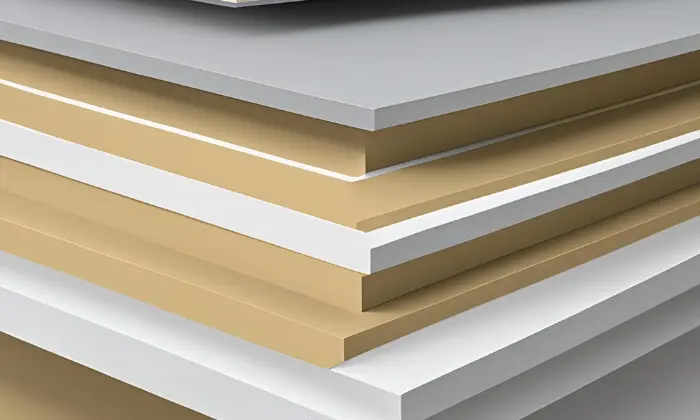How Thick Is Drywaal? Understanding Drywall Thickness
- - Category: Constrution
- - 22 Jul, 2024
- - Views: 62
- Save
we will explain the different thicknesses of drywall, the sizes available, and what thickness is best for your project.
When you're working on building or remodeling a house or office, knowing about drywall thickness is important. Drywall, also called gypsum board or plasterboard, is a key material for making walls and ceilings. This guide will explain the different thicknesses of drywall, the sizes available, and what thickness is best for residential and commercial projects.
What is Drywall Thickness?

Drywall comes in various thicknesses. The most common ones are 1/4 inch, 3/8 inch, 1/2 inch, 5/8 inch, and sometimes, 1 inch. Each drywall thickness has its own use, so picking the right one for your job is essential.
1/4 Inch Drywall
1/4 inch drywall is the thinnest option. It is used for:
- Curved Walls: It bends easily, making it good for curved surfaces.
- Covering Walls: You can use it to cover existing walls or ceilings to add extra layers for better insulation or soundproofing.
This thin drywall is flexible and light but not as strong as thicker ones.
3/8 Inch Drywall
3/8 inch drywall is a bit thicker and is often used for:
- Repairs: Good for fixing walls and ceilings where thinner drywall was originally used.
- Old Homes: Suitable for older houses with uneven walls.
It provides more strength than 1/4 inch drywall but is still lightweight.
1/2 Inch Drywall
1/2 inch drywall is the standard thickness for most home walls and ceilings. Its benefits include:
- Versatility: Works well for most walls and ceilings.
- Availability: Easy to find and affordable.
- Ease of Use: Simple to handle and install.
This thickness is strong enough for most home projects.
5/8 Inch Drywall
5/8 inch drywall is thicker and stronger, often used in both homes and businesses for:
- Fire Resistance: Better fire protection, making it suitable for fire-rated walls and ceilings.
- Soundproofing: Helps reduce noise between rooms.
- Strength: Provides added support for heavy fixtures.
Building codes often require this thickness for its fire-resistant properties.
1 Inch Drywall
1 inch drywall is not common but used in special situations:
- High-Security Areas: Offers maximum durability and impact resistance.
- Soundproofing: Best for sound insulation, ideal for studios.
This very thick drywall is heavy and hard to install, usually needing professional help.
Drywall Sizes for Homes
For home projects, the most common drywall sizes are:
- 4 x 8 Feet: Standard size, easy to handle, fits most rooms.
- 4 x 12 Feet: Fewer joints in larger rooms, leading to a smoother finish.
The size you choose depends on the room dimensions and how many joints you want to avoid.
Drywall Sizes for Businesses
Commercial projects often need larger and thicker drywall sizes to meet building rules and needs. Common sizes include:
- 4 x 12 Feet: Good for large spaces, fewer seams.
- 4 x 14 Feet: Used for high ceilings or big walls to minimize joints.
- 4 x 16 Feet: Ideal for very large areas, though harder to handle.
Thicker drywall, like 5/8 inch or 1 inch, is more common in businesses for better fire resistance and soundproofing.
Special Types of Drywall
Apart from thickness, drywall comes in different types for specific uses:
Moisture-Resistant Drywall
Also known as green board or blue board, used in:
- Bathrooms: Protects against mold.
- Kitchens: Adds moisture resistance.
Fire-Resistant Drywall
Known as Type X drywall, used in:
- Fire-Rated Walls: Required in some areas for safety.
- Garages: Extra fire protection between the house and garage.
Soundproof Drywall
Also called acoustic drywall, used in:
- Home Theaters: Reduces sound transfer.
- Bedrooms: Provides a quieter living space.
Choosing the Right Drywall Thickness
Picking the right drywall thickness depends on:
- Room Size: Larger rooms need larger sheets to reduce seams.
- Function: Consider needs like moisture resistance for bathrooms or soundproofing for theaters.
- Building Codes: Follow local rules, which may require certain thicknesses for safety.
Tips for Installing Drywall
Good installation ensures your drywall lasts long and works well. Here are some tips:
- Prepare: Make sure walls and ceilings are clean and dry.
- Cutting: Use a sharp knife for clean cuts and measure twice.
- Hanging: Start with the ceiling, then the walls. Use screws or nails to secure the drywall.
- Seaming: Apply joint tape and compound to seams, sanding between coats for a smooth finish.
Conclusion
Knowing about drywall thickness and sizes is crucial for any building or renovation project. Whether you're working on a home or a commercial building, choosing the right drywall ensures durability, fire resistance, and soundproofing. By considering the needs of your project and following good installation practices, you can achieve excellent results that will last for years.
